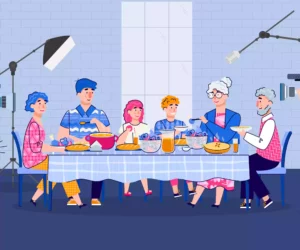
The music of a movie is part of its essence. Suppose you watch your favourite scene without the background music. You will soon realise just how integral it is to the movie’s experience. The Original Soundtrack (OST) complements the drama while still standing on its own as a beautiful work of art. Filmmakers find the sound of a movie not just in original compositions but in pre-existing songs. These songs reflect both the mood of the film and the director’s own taste. From yesteryear country songs to pop ballads, a filmmaker’s musical choices are extremely significant. Let’s explore some ways in which music in film brings new meaning and life to any tune.
Finding the sound
Some movie soundtracks are so unforgettable in our hearts and intrinsically linked to the movie that just a hint of the tune conjures up old memories. You don’t have to be an avid movie buff to be transported to the wizarding world of Harry Potter when you listen to John Williams’s ‘Hedwig’s Theme’. Similarly, when you hear Howard Shore’s award-winning soundtrack for The Lord of the Rings, you immediately picture Middle Earth. Even when an old song is used as Background Music (BGM) in a movie, it becomes part of the movie’s legacy after that.
Quentin Tarantino, for instance, does this to significant effect. Think of ‘Misirlou’ (1962) in Pulp Fiction (1994), ‘Stuck in the Middle’ (1972) in Reservoir Dogs (1992), and ‘Nobody But Me’ (1967) in Kill Bill Vol.1 (2003). It’s impossible to think of those songs now without the iconic movie visuals. However, unlike other movies, the music in Tarantino’s works does not seek to place the story in its historical setting. Instead, he uses it to enhance the mood he wishes to create by evoking or drastically contrasting it.
Take movie adaptations of Jane Austen’s writings and such Regency/Victorian period pieces, for instance. They exclusively use classical music as BGM, from the likes of Jean-Yves Thibaudet: a lot of French classical arrangements featuring the piano. The makers of Bridgerton, on the other hand, have gone another direction creatively. They have come out with instrumental covers of contemporary songs. These pieces have brought the audience into the characters’ mood (where traditional classical music might have alienated them). This style also challenges the distinction between high and low art, as the upper-crust folk of Ton dances to Pink and Miley Cyrus.
Music in film: going old school
Shonda Rhimes has always used contemporary music in her shows. For example, Grey’s Anatomy popularised such songs as ‘Chasing Cars’ and ‘How to Save a Life’. Using the songs multiple times on the show, Rhimes can communicate a mood, a dynamic, or even a narrative arc without dialogue. Syncing songs with shows is also a great way for labels to promote upcoming artists. With that in mind, there isn’t as much commercial value in using old songs. Kate Bush’s ‘Running Up That Hill’ may have peaked at No.4 on the Billboard Top 100 after Stranger Things. However, although most films feature old songs, the chart-topping phenomena are few and far between. Perhaps the synergy of a good movie, good music, and a filmmaker who is quite deliberate with their musical pairings is the recipe for success.
Despite such odds, some golden numbers from back in the day never go out of style in films. They continue to be featured in the mainstream and covered by other artists. ‘Bohemian Rhapsody’ came back into the Billboard Top 10 when featured in the biopic of the same name in 2018 and Wayne’s World in 1992. Another biopic track that became a chart-topper is Straight Outta Compton; the NWA song of the same name debuted at No. 38 following the film’s release in 2015. In 1986, the Beatles’ festive ‘Twist and Shout’ (1963) reached No. 23 on the charts after featuring in cult classics Ferris Bueller’s Day Off and Back to School. In both instances, the directors used the music in the films to accentuate the protagonists’ happy-go-lucky joie de vivre, leading a new generation to dance to music from 23 years ago.
Yet another example is the classic ‘Stand By Me’ (1961). This song reached No. 9 after featuring in a movie of the same name in 1986 and a Levi’s commercial in 1987. Around the same time, Good Morning, Vietnam used Louis Armstrong’s ‘What a Wonderful World’ as BGM while the visuals slowly revealed the terrors of the Vietnamese war. Both these songs have been featured and covered in so many different ways over the years that they are now ubiquitous worldwide.
#trending
Musical trends change through the ages. Some recreated songs are so successful that most people don’t realise they’re not originals. My favourite instance of a piece that has aged well is ‘When I’m Gone’ (1931) by The Carters Family. In 2009, 78 years later, Lulu and the Lampshades reworked the song, using cups and clapping to provide the beats. In 2011, Anna Burden did a cover of the Lulu and the Lampshades’ version, also using the ‘cup clap’ technique. The video caught Anna Kendrick’s attention on Reddit, and she performed it in Pitch Perfect. The music video for Kendrick’s version of the song, called ‘Cups’, was released in 2013. The track reached No.6 on the Hot 100. After that, covers and tutorials of ‘Cups’ became fast-consumed uploads.
The internet also has the potential to revive a dwindling band. When The Sopranos finale aired, it marked the end of an era and the rebirth of another viral song—‘Don’t Stop Believin” by Journey. The power ballad started gaining momentum online. Soon, it became a classic in the new millennium rather than the guilty pleasure it previously was.
Marvel Musical Universe
The MCU has a penchant for using brilliant 20th-century music in film. When AC/DC’s ‘Back in Black’ or ‘Shoot to Thrill’ plays, Iron Man comes to mind. But the Marvel Musical Universe star is, without doubt, Guardians of the Galaxy. The James Gunn movie has an enviable 70s playlist, with such hits as ‘O-o-h Child’, ‘Fooled Around and Fell in Love’, ‘Bring It On Home,’ and ‘Hooked on a Feeling’. This movie is now symbolic of Marvel’s ability to produce superhero hits without any prior fanbase. Peter Quill’s ‘Awesome Mix Vol.1’ became the first soundtrack to top the Billboard 200 chart without any new songs.
Taika Waititi’s rock n’ roll treatment of Thor: Ragnarok was just as epic. Led Zeppelin’s ‘Immigrant Song’ (1970) hooked fans. Younger audiences, I am sure, will identify the song more from the movie’s soundtrack. The recently released Thor: Love and Thunder also has its share of musical brilliance with songs from Guns N’ Roses and ABBA. In any case, young listeners will most likely find some old favourites for the first time through the music in that film.
Music in film is not just a vehicle of storytelling anymore. It is practically a central character pulling its weight. Sometimes, we recognise this character from a different time. Other times, we meet the character anew and fall in love. Either way, music has come to form an artistic symbiosis with cinema. It makes me wonder if future generations will experience this nostalgia through our current music in future films. Or perhaps we’ll incur their wrath. But that’s a question for another time.


